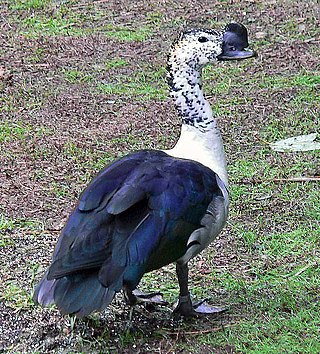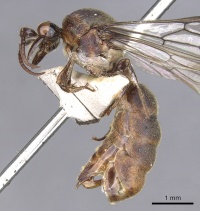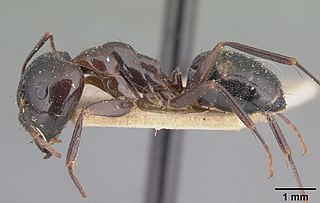
Sarkidiornis is a genus within the family Anatidae comprising two species that inhabit aquatic environments in tropical and subtropical regions of South America, Africa and southern Asia.. Sarkidiornis is sometimes considered a monotypic genus with its sole member the knob-billed duck, a cosmopolitan species.
Tripsacum laxum, the Guatemalan gamagrass, is a species of grass in the family Poaceae. It is a larger perennial bunchgrass of the Caribbean, Central America, such as in Nicaragua and Guatemala, and North America in southern Mexico.

The Hemiphractidae are a family of frogs from South and Central America. Previously, this group had been classified as a subfamily (Hemiphractinae) under family Hylidae. More recent research classifies these genera into their own family, or sometimes into three separate families: Amphignathodontidae, Cryptobatrachidae, and Hemiphractidae. An active question still exists as to which of these groupings is more accurate.
The New Ireland forest rat is a large rodent in the family Muridae. It is endemic to New Ireland, in the Bismarck Archipelago, Papua New Guinea.
Lasioglossum serenum, also known as the Lasioglossum (Nesohalictus) serenum, is a species of bee in the genus Lasioglossum, of the family Halictidae.
Anthidiellum krombeini is a species of leaf-cutting bee in the genus Anthidiellum, of the family Megachilidae.

Ephemera guttulata, commonly known as the eastern green drake, shad fly and coffinfly, is a species of mayfly in the genus Ephemera. The eastern green drake is native to the continental United States and Canada. Its conservation status per the NatureServe conservation status ranking system is G5, meaning it is secure.
Aenictus longi is a species of tannish beige army ant found in Bangladesh, and India. The species has two subspecies, Aenictus longi longi, and Aenictus longi taivanae.

Aenictus aratus is a species of beige and dark brown army ant found in Northern Australia. Parasitic depredation has been observed from Phoridae flies.
Aenictus fuscipennis is a species of light brown army ant found in Indonesia.
Aenictus idoneus is a species of brown army ant found in Indonesia.
Aenictus feae is a species of brown army ant found in Bangladesh, Myanmar, and Yunnan.

Aenictus grandis is a species of dark brown army ant found in Bangladesh, Myanmar, and Yunnan.
Aenictus mentu is a species of brown army ant found in Sudan.
Camponotus coriolanus is a species of carpenter ant found in Brazil.
Camponotus divergens is a species of carpenter ant found in Brazil.
Camponotus ephippium is a species of carpenter ant found in Australia. It has two subspecies, C. ephippium ephippium and C. ephippium narses.
Camponotus fayfaensis is a species of carpenter ant found in coastal regions of Yemen, Saudi Arabia, and the UAE.

Camponotus gibber is a species of carpenter ant found in Madagascar.

Notiosoricini, whose members are known as the North American gray shrews, is a tribe of shrews in the family Soricidae, including the genera Megasorex and Notiosorex. They are found across the southwestern United States and most of Mexico.






